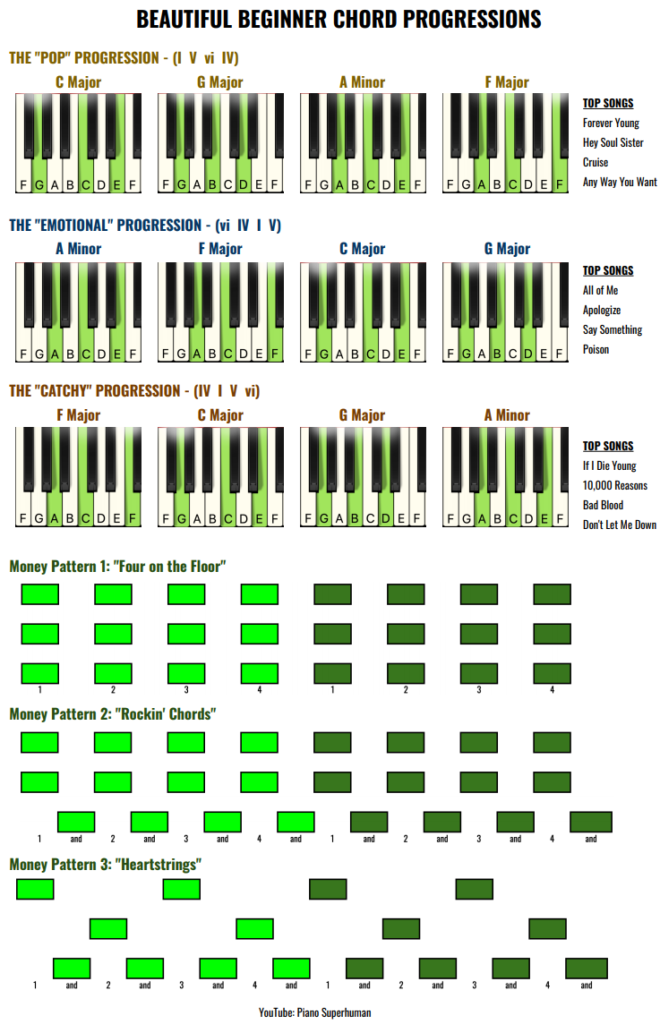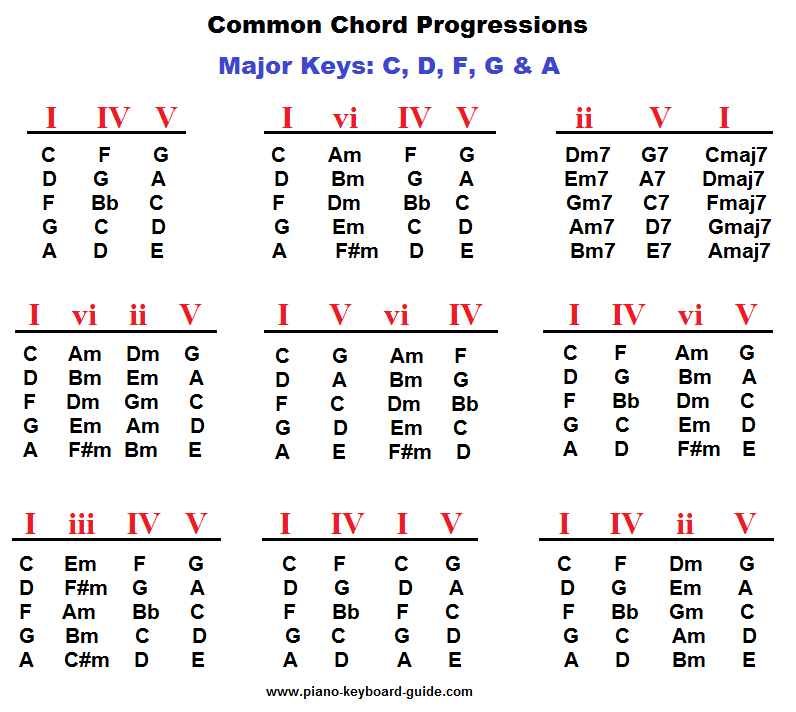Chord progressions in piano are sequences of chords that create the harmonic backbone of a piece of music. They establish the tonal foundation and emotional resonance of a song.
In the realm of piano playing, mastering chord progressions is crucial for aspiring musicians, as it equips them to understand and create a wide array of musical styles. Typically, these progressions are denoted by Roman numerals that represent the scale degree of their root notes within a given key.
With numerous possible combinations, chord progressions offer a vast landscape for composers and performers to express different moods and narratives. Learning common progressions like the classic I-IV-V-I helps pianists progress from simple tunes to complex compositions, enhancing their improvisational skills and overall musicality.
The Heartbeat Of Music: Chord Progressions On Piano
Imagine a heart pulsing, giving life to a body. That’s what chord progressions do for music, especially on the piano. Chords form the foundation of all piano music. They create emotions and tell stories. We feel happy, sad, excited, or calm through chord progressions. It’s like painting with sounds. Each color is a chord, and their combination makes beautiful music. In piano, chord progressions are keys to unlocking the beauty of a song.
Chords And Their Role In Music Creation
Chords are groups of notes played together to create harmony. Think of them as friends holding hands. They support each other to create a full sound. Pianists use chords to add depth to melodies. Without chords, piano music would sound empty. It’s like a movie without a background set.
- Major chords – bring out happiness and brightness.
- Minor chords – create a sad or reflective mood.
- Seventh chords – add a jazzy feeling or a sense of tension.
- Suspended chords – instill a feeling of anticipation or suspense.
Decoding The Chord Progression: A Pianist’s Map
Every pianist learns to read the map of chord progressions. A chord progression is a journey from one chord to another. It guides the song’s flow and energy. A well-chosen chord progression can make a simple tune sound complex.
Here’s an example of a common chord progression in the key of C:
| Chord | Name | Notes |
|---|---|---|
| C Major | I (Tonic) | C-E-G |
| A Minor | vi (Sixth) | A-C-E |
| F Major | IV (Subdominant) | F-A-C |
| G Major | V (Dominant) | G-B-D |
Master piano players mix different chords to stir emotions. Playing with chord progressions is fun. You can discover new sounds and feelings. Each chord change takes the listener on a new path.
By practicing chord progressions, pianists enhance their musical storytelling. It’s a key skill for composing songs and improvising. It’s like making a new recipe. Each ingredient must blend well with others to create a delicious dish.

Credit: www.bestpianoclass.com
Building Blocks Of Chord Progressions
The Building Blocks of Chord Progressions serve as the foundation for much of the music we play and hear. On the piano, these progressions give life to melodies by providing a pattern of chords that create a sense of movement and resolution. They’re like roads on a musical map, leading us through different emotions and stories. Understanding the components that make up these progressions is key for any emerging pianist or music enthusiast.
Scale Degrees And Chord Quality
Chords on the piano are built using notes from scales. Each note in a scale has a number, known as a scale degree. For example, in the C Major scale, C is the first degree, D is the second, and so on. These degrees help us form chords. Chord quality refers to the type of chord we create, such as major, minor, diminished, or augmented. The quality is determined by the intervals between the notes originating from the scale degrees.
- Scale degree 1 gives us the root chord
- Quality shapes the mood (Major=happy, Minor=sad)
- Chords are labeled with Roman numerals (I, II, III, etc.)
Harmonic Function: Tonic, Dominant, And Subdominant
Understanding harmonic function is like knowing why each piece of a puzzle fits where it does. Three main roles define this in chord progressions:
- Tonic (I): The home chord, where music feels at rest
- Dominant (V): Creates tension, lures us away from home
- Subdominant (IV): The bridge between Tonic and Dominant
When we play these roles using different chords, we tell a musical story. The Tonic chord is like a starting point, while the Dominant adds conflict or drama. The Subdominant paves the way for the story to develop. Together, they create a full, rounded musical experience on the piano.
By mastering these elements—scale degrees and chord quality, along with the roles of Tonic, Dominant, and Subdominant—pianists build the framework for gripping musical tales.
Popular Chord Progressions In Piano Music
Chord progressions are the backbone of piano music. These sequences of chords form the harmony of a song. Many songs share common progressions. Knowing these can help you play and understand lots of music.
The Classic ‘four Chords’ And Pop Music
The ‘four chords’ progression reigns in pop music. Its simplicity and catchiness create memorable melodies. This progression uses the chords I-V-vi-IV. Here’s why it’s popular:
- Easy to learn: Beginner pianists can quickly grasp these chords.
- Versatile: It fits many different melodies and music styles.
- Harmonious: These chords sound pleasing together, making them a favorite.
Dozens of hits have these four chords. Take for example, Journey’s “Don’t Stop Believin'” or Adele’s “Someone Like You”.
Jazz And The Ii-v-i Progression
Jazz music loves the II-V-I progression. It’s the foundation of jazz harmony. Here’s a quick look:
- II: Sets up the tension.
- V: Builds on that tension.
- I: Resolves it in a satisfying way.
Songs like “Autumn Leaves” and “All The Things You Are” feature the II-V-I progression. They showcase how it can evoke deep emotions and complexities in jazz.

Credit: www.piano-keyboard-guide.com
Playing Techniques For Smooth Transitions
Chord progressions are the backbone of any piano piece. They set the tone and emotion, guiding the listener through a musical journey. Smooth transitions between these chords can elevate your playing from good to mesmerizing. Masterful playing techniques are essential for fluid movement across the keys.
Finger Positioning And Movement
Proper finger positioning is crucial for smooth chord transitions. Rest your fingers gently on the keys with a natural curve. Imagine holding a small ball in each palm. This technique prevents strain and ensures fluidity.
- Number your fingers from thumb (1) to pinky (5) for reference.
- Plan your fingering before playing a progression.
- Use pivot fingers to anchor your hand while changing chords.
- Practice finger independence with scales and exercises.
Having your fingers glide from one chord to the next without jumping makes for a seamless sound. Look ahead and visualize your next move.
Voice Leading For Elegance And Efficiency
Voice leading is the art of moving between chord tones with minimal distance. Each note in a chord is a voice. You want these voices to travel short paths.
- Identify common tones between chords and keep them in place.
- Move other notes to the nearest available chord tone.
- Practice with major and minor triads to get comfortable.
This technique often involves inner fingers moving slightly while outer ones may remain static. It results in elegantly connected chords that feel almost effortless.
Creative Exploration Through Chord Progressions
Mastering chord progressions on the piano opens up a world of creativity. Pianists can craft unique sounds by shifting from one sequence to another. Chords form the backbone of most piano music. Creative chord progressions stimulate emotion and provide the foundation for melody and harmony. Ready to dive into the endless possibilities? Let’s explore how experimenting with chords can ignite your musical journey.
Experimenting With Inversions And Additions
Chords are not just static shapes. By experimenting with inversions, you can find new textures. An inversion involves switching the order of notes. This alters the sound without changing the chord’s core. Inversions can lead to smoother transitions and fresh iterations of familiar tunes. For those eager to add complexity, try adding notes to your chords. These additions can be sevenths, ninths, or even nontraditional tones. They add color and depth to your music.
- Try using different inversions to see how they change a song’s feel.
- Experiment with adding sevenths or ninths for a richer sound.
- Notice how these changes affect the melody on top
Blending Genres And Breaking The Rules
Blending genres is like a chef fusing cuisines. It creates exciting new flavors in music. Mix jazz chords into a classical piece for an unexpected twist. Combine rock rhythms with pop chord progressions for a catchy blend. Remember, rules in music are starting points, not limits. Feel free to break them and forge your path. This approach can lead to innovative compositions that stand out. Do not shy away from odd chord combinations. They might be the next hit sound.
- Mix chords from different genres and observe the outcome.
- Create your hybrid style by blending unexpected elements.
- Embrace the unique soundscapes crafted by your experiments.

Credit: www.schoolofrock.com
Practice Makes Perfect: Mastering Progressions
The journey to becoming a piano maestro intertwines with the mastery of chord progressions. These sequences set the foundation for songs and are pivotal in creating emotion and structure within music. As the adage goes, with diligent practice, perfection becomes attainable. Budding pianists must immerse themselves in structured routines and use chord progressions as a stepping stone for original compositions.
Structured Practice Routines
Developing efficiency at the piano requires a well-planned approach. Set clear goals for each session. Create a schedule that includes:
- Warm-up exercises with simple progressions
- Incremental difficulty levels
- Time for reviewing challenging chords
Record progress in a practice log. This log helps identify strengths and areas for improvement. Dedicate parts of your session to playing along with tracks, a fun way to apply learning in real-time.
Using Progressions To Compose Original Pieces
Chord progressions offer a canvas for creativity. Follow these steps:
- Start with a four-chord progression you enjoy
- Experiment with melodies on top of these chords
- Vary the rhythm and tempo to discover unique sounds
Use a digital audio workstation for recording ideas. Mix and match different progressions to form a complete piece. This hands-on approach bolsters understanding and skill.
Can I Use Chord Progressions to Play “What a Beautiful Name” on the Piano?
Yes, you can use beautiful name piano chords to play “What a Beautiful Name” on the piano. The song uses simple chord progressions that can be easily learned and played. With practice, you can master the beautiful name piano chords and play the song with confidence and skill.
Frequently Asked Questions Of What Are Chord Progressions Piano
What Is The Purpose Of Chord Progressions?
Chord progressions create the harmonic foundation of a song, setting its mood and guiding melodic elements. They establish musical movement and provide a structure for composers to build upon.
What Are The Basic Chord Progressions?
Basic chord progressions include the I-IV-V, II-V-I, and I-V-vi-IV. These sequences form the foundation of many songs and are key in music composition and improvisation.
What Is The Difference Between Chords And Progressions?
Chords are a set of notes played simultaneously, while progressions are a series of chords played in sequence to form the harmonic backbone of a song.
What Are The 4 Progression Chords?
The four progression chords are commonly known as I (tonic), IV (subdominant), V (dominant), and vi (submediant) in music theory.
Conclusion
Navigating the realm of chord progressions on the piano unlocks a universe of musical expression. With the basics now in hand, you’re set to craft melodies that resonate with emotion. Let this guide fuel your journey as you discover the harmony within each keystroke.
Embrace practice, and watch your compositions come alive.
